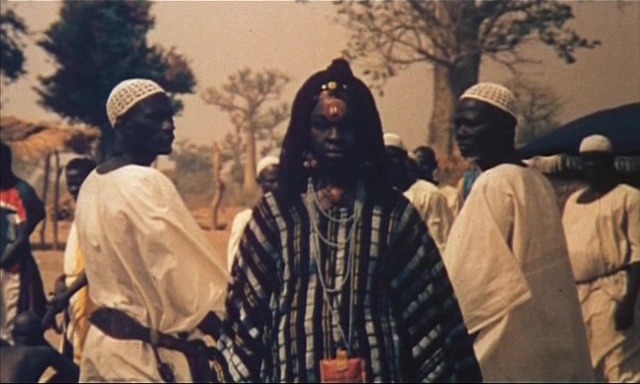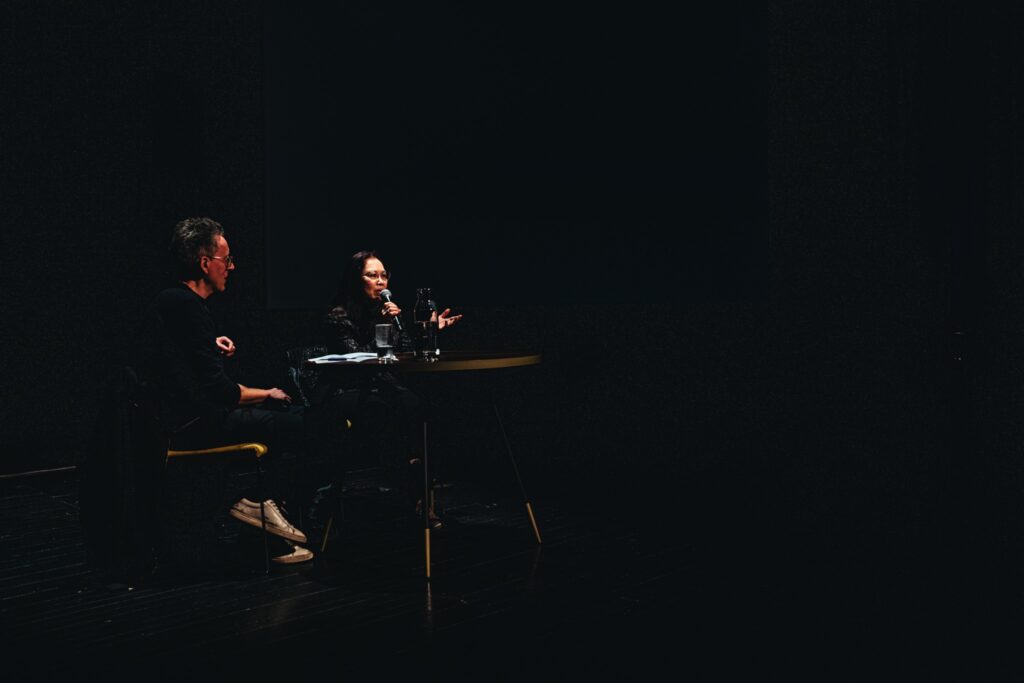An attempt to assemble critical pieces approaching cinema “from the standpoint of sound”. A conversation between Serge Daney and Noël Simsolo on Ennio Morricone and Sergio Leone, first broadcasted on 24 February 1989 on France Culture. Part of Noël Simsolo’s series “Musiciens pour cinéastes”. Translation found on http://sergedaney.blogspot.com.
SIMSOLO: This was the music of Once Upon a Time in America, Sergio Leone’s last film, hopefully not his final one. Serge Daney, you remember that one day we had lunch with Sergio Leone and what had struck you that you didn’t know at the time was this sort of precision in what he was doing. Despite appearances, he was very conscious of what he was doing. And although he was attacked by critics at first: destruction of the American western genre, phoney filmmaker that caricatures things, bit of a joker, etc, he slowly established himself as an obvious style, rejected or embraced, but clearly a style, total and consistent. When he makes Once Upon a Time in America, there is a use of the mythology of the cinema of Hollywood, of archetypes of the America of the 30s, 40s, 50s, 60s and 70s. And with Morricone, his old accomplice as he said very clearly in the interview we just heard, a research so that the sound outline of the film, sound and music, integrate elements of originality and dramatisation but without illustrating. He is not a filmmaker that uses music as an illustrator, like Hawks for example, but uses music like total element of the fiction. So I’d like to put the question to Serge Daney, film critic but also sport and society critic: how do you feel the effects of this unique work?
DANEY: What strikes me is that we have realised very late that music in the American cinema was broadly a rehash of the Viennese School through the Jewish, German, Austrian and Hungarian musicians who left Europe for America. And we accepted this so naturally that we forgot to ask a very simple question. There has been a serious American music, and I do say “serious”, which is not bad at all, and which almost doesn’t feature at all, apart in some musicals, in the American cinema. And one only has to listen again to some records on 20th century American music to discover people that are relatively known, like Ives for example, to realise that there has been a music that tried to take into account European classical music and something specifically American (marching bands, choral societies, guimbards, hymns from North and South, of the Civil War, etc). This music is not in the cinema.
SIMSOLO: except a bit in Ford’s films.
DANEY: A little bit with Ford. Wagon Master for example. Things like that but rather in the minority. And it came down to an Italian filmmaker, a childhood friend of an Italian musician: Ennio Morricone, a pupil of classical music, to bring back through Italy – the pure conscience of classical music – that there had been an American music which was called Charles Ives, Aaron Copland, Virgil Thompson. People like that with a bit of jazz, a lot of popular music. And so it was thanks to Italy, and musically as well, not just the relation between Leone and Ford – Leone as the ultimate heir to Ford – but also Leone as the ultimate heir to Ives, let’s say. With a sort of village cacophony, with very simple melodies, and some very complex things, mixed together and having nothing to do with the serious music of the Viennese School.
SIMSOLO: A sort of return of America and its music via a European. Whereas until now Europe had fed Hollywood and Europe had fed from Hollywood.
DANEY: Yes, I would say that it’s the Europeans who have sent the pupils of Schoenberg or Bartók to Hollywood. But it’s also one European, two Europeans, two Italians, late, in the sixties, who implicitly said to the Americans: listen as well to your own musicians, the locals, from your village.
SIMSOLO: I’ll give you an anecdote that Sergio Leone told me. Maybe you were there. He said “The first time that I saw Morricone, I asked him: What did you do before?”. And Morricone said “The music of some western film”. “But that is bad Tiomkin.” And Morricone replied: “But what if they had commissioned bad Tiomkin?” And I think this is very revealing of what you have just said. For a while, through the imitation of the Hollywood system via the Italian or German series of fake westerns, musicians were asked to compose fake Tiomkin music or fake Waxman or fake Steiner music. Morricone was doing this but when he meets Leone, this is no longer what needs to be done. One has to return to the real.
DANEY: And the real when it comes to America is something quite simple. It’s a rather exploded culture, with many different parts, with a mix of very serious and very popular things, something lost in Europe. And what Morricone does with some magnificent melodies but also very refined orchestrations is to bring – apologies for the slightly pompous word – a carnivalesque dimension, in the way Bakhtin meant it, a heterogenous mix of things. So in the music that Morricone composes for Leone there are the guimbard (which in the end refers to the Jew’s harp), Viennese waltzes, and there is mainly military music. And military music is extremely important with Leone because he is perhaps the last filmmaker that is profoundly pacifist, anti-militarist actually, to make films. There is a description of war in The Good, the Bad and the Ugly, a hate of war, which apart from Ford, the Ford of The Horse Soldiers, had never really been shown in the American cinema.
SIMSOLO: And what also happens is that the music of Hollywood, illustrative or contrapuntal, or to think of it in as a function in the fabric of cinema, played either the theme of the character, and Morricone knew how to do this, as we’ve seen with Addio a Cheyenne, or of the situation, but rarely played the profound origin of people. It’s only with Ford that when a character arrived, we heard in the music some Irish rhythms to guess his origins. Whereas with Leone and this is what we will hear now. Since in Once Upon a Time in America, it’s about the Jewish mafia, one character is going to play the pan flute, as someone could have played it in the Palestine of the 1910s. And it’s mixed with the rest of the music, which means not only there is the character and the situation but there is also what the character fundamentally is, and he can’t function in any other ways than through his profound origins, and that music becomes in this instance not only part of the fabric but also an element of the analysis we can make about the cinema.
DANEY: We could say that this is the music that De Mille couldn’t create.
(…)
SIMSOLO: So as we reach the end of this series of broadcasts, there are a few things I’d like to say which are a bit anecdotical, slightly beside the point. But it’s true that when we got to know each other at the end of the 60s, at the time of the Cahiers du cinéma, before Cahiers du cinéma take an ideological turn, we sometimes found ourselves in popular film theatres with people like Jacques Rivette who watched films by Leone, who had been rather despised at some point, and who found an immense force in his cinema. And it’s also true that the force we found in Leone wasn’t just the mise en scène, in the flattest possible sense of the term, meaning how one enters the field of camera, how one cuts, how one constructs a close-up, but also the whole of the tapestry, of the mechanic that was rendered. And it’s true that even though critics like those at Cahiers du cinéma and other precise critics didn’t take the music in film as a fundamental element of the quality of a film. There was even this sentence if you remember that said “when the music of a film is good, we don’t hear it, we don’t remember it.” Leone and Morricone have reversed this problem. It is not possible to think of Leone without Morricone’s music as the interview I conducted with him in Annecy just reminded us. And we have the impression today, twenty years later, is that this crystallization that he managed to operate between a very present music and a very present cinema modified the way in which people use music in cinema.
DANEY: And you inadvertently just said the word that allow me to make a link…
SIMSOLO: Why “inadvertently” Serge?
DANEY: Hold on. You don’t know which word I mean. It’s “crystal”. I didn’t invent that. It’s in the tome two of Deleuze’s book where there are some beautiful things about the cinema. And he talks about certain filmmakers, not Leone because perhaps he doesn’t know him well enough, but he talks about Renoir, people like that, about Ophüls with whom it is already more telling, and he talks about the structure of the crystal. This means that the ensemble of the things that happened, character by character, action by action, memory by memory, is in a crystal. So we can’t touch it. And inside the crystal, there is a small merry-go-round. And each character is riding his own merry-go-round. And the merry-go-round is circular meaning that the characters can’t escape the crystal. It is the past. Fossilized but always ready to return, with the same intact emotional force.
SIMSOLO: Yes, like in the finale of The Good, the Bad and the Ugly where the dead punctuate the duelling trio.
DANEY: Exactly. It takes place in front of a cemetery, in front of the dead. And perhaps because of Leone and also Demy with Les Parapluies de Cherbourg as it’s around the same time, there has been the possibility for a film to have a music that was both in complete synchronicity, in complete osmosis with the film, a music that said the same thing as the film, that there was this unforgettable and slightly idiotic crystal where people turn round in circles, are in cycles, do the same gestures, the same mistakes, the waltz of the shadows, and that we could remember the film or the music individ… indifferently. It set a precedent, for better or worse, often for the worse. And the most moving moment is the starting point: Leone. Leone is the first who made films, with Morricone as a magnificent accomplice, where the crystal was eternal. And what could we see inside the crystal? We could see both refrains, which is very Italian, like Nino Rota, differently but in the same way as Nino Rota. Something that an American can’t do. An American can’t create a refrain because he is caught in the countdown of an action. He can only compose a melody with a final catharsis like Tiomkin. Italians have always composed melodies, even refrains and choruses which they have even integrated into classical music. Morricone did this and it matches perfectly with the Leonian project which was to say: look at the cinema we no longer know how to make, let’s say Ford to be quick, before it disappears, and look also at the cinema that is coming: a cinema where we are going to take sample / signs, where we will be between fashion, advertising, short forms, recitative forms, extremely pathetic, where each character do their act, in a loop, with accompanying music.
SIMSOLO: I remember showing to an editor, Khadicha Bariha who worked with Chris Marker, films by Leone that she didn’t know but knew of reputation: popular films, etc. And seeing these films as the technician that she was, as someone who sticks together images and sounds to make a film, she told me “it’s strange, these are auteur films, totally”. Meaning there isn’t one element that has not been thought of. The films are popular but are fundamentally auteur films, as much as Straub or Garrel. And what’s very peculiar in the crystallisation that I was referring to. Leone, while playing a card completely distinct from popularity, but by mixing different elements, managed to give back to the popular cinema its great lyrical force, while never abandoning anything from his own project. And this is where others like Peckinpah have tried but not succeeded as well. For them, the musician, the actor, the archetype, the script, the décor, and always the music, came like an opera which was the musical opposite of the libretto, like a permanent counterpoint, to give a breathing to the modern cinema that we were expecting. That Leone and Morricone gave to us and that for years nobody had seen it.
DANEY: Nobody saw it but everybody took it, everybody copied it, digested it. His films have entered a sort of vague and obscure collective conscience. And now we see very well that Leone was the first, not only to have announced things that are common today, but to have said: this is the river bank we are leaving behind, and this is what is in front of us. What we leave behind is the painting, the symphony. And what we are heading towards is the sampling. We sample qualities from a character, a character from a décor, a rather empty décor. We become incredibly sensitive to a mix of hyper realistic documentary (Leone has observed the true West a lot) which becomes a neo-neorealism [term prompted by Simsolo] and we could say that if there was a history of the sur-figurative, Leone would be its starting point, but more friendly and moving than its current forms because Leone still knows after what this is coming. So this is really a mandatory passage. It’s like the bridge in The Good, the Bad and the Ugly. We blow it up in the end. But once it’s been blown up, we’ll have a lot of difficulties in continuing to tell stories.
SIMSOLO: There’s also something more technical. What has always titillated me with Leone is that I have listened to a lot of soundtracks which were illustrative, contrapuntal, theme of a character, theme of a situation. But with Leone, something very strange happened. The feeling of the montage: close-up, medium shot, relations between the two to be structuralist. The instruments played a role. When the pan flute plays, it indicates a certain framing of the image. When it’s the Jew’s harp, it’s something else. Music is not here just as a total element of the tapestry, it is sometimes like in painting or in modern music, a given element that can redefine itself and recompose itself. And it’s particularly striking because it’s only Morricone with Leone, not with the others.
DANEY: What Morricone does with music is the equivalent of what Leone does with his shots. He gives a feeling of what is close and what is far. Of what we are getting close to and at what a musical close up would look like. What we often take as melodies, magnificent of course, are close-ups. And what we take for complex orchestral things, are simply long shots. And to have worked with someone who was doing in his domain, his art, music, the same effort of distancing to take a general view, or of tightening to get to a close-up is something absolutely unique. And it’s true that Morricone didn’t do it with the others.
SIMSOLO: That’s the problem. Because with the others, it was: here’s the music, do what you want with it. With Verneuil, with Don Siegel, with great filmmakers. What’s surprising with Leone is this osmosis that we haven’t found elsewhere. Like Rota with other filmmakers than Fellini.
DANEY: This what everybody can understand today with the Dolby, the compact disc, or spatialised music. Music is also in the space. And people in the sixties must have felt implicitly, very directly, that the space that Leone was fracturing in a very inventive way, by keeping in turns the general picture and the close-up, the other one, in music, was doing the same.




